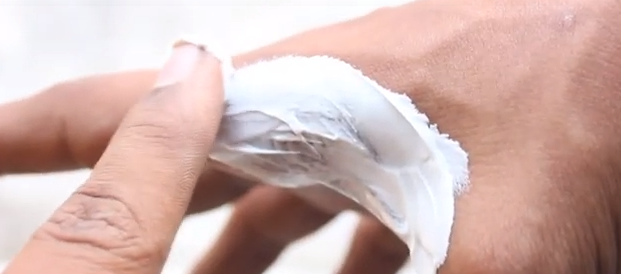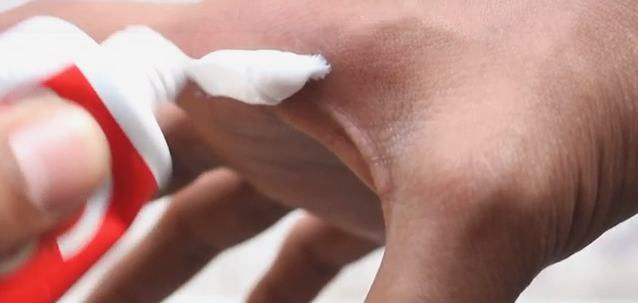Toothpaste for Burns

This is your introspective primer on when and where to apply.
Following Cold Water?
Some people recommend putting toothpaste on burns after running under cold water, which might work in certain situations. First of all, you’ll want to make sure the water is nice and cool, not freezing cold, before you run your burned area under it. Do so for about 20 minutes.
Afterward, you’ll want to use water of that same temperature, along with some mild soap, as after wash. According to Mayo Clinic, it’s wise to note the severity of the burn and, if the situation and its pain/intensity do not diminish, then to seek a professional doctor for immediate consideration. Also, you’ll want to follow up on the cold water treatment with a quick wet compression, through a tissue or rag. Soak it all in.
Toothpaste for Burns: Never?
But wait --- there is another side of the coin we have not fully assessed. Some, on the flip side, have been known to say, "Never put toothpaste on a burn" for so many other stated reasons. Now let’s talk about why it is a bad idea, perhaps, to put toothpaste on your burn, whether before wet-compressing it or otherwise.

First, perhaps the most prominent case that most on the other side of the argument would make is that applying toothpaste will cause dangerous, harmful chemicals to enter the body through the skin --- directly by means of the burn; while there is an element of truth to this statement, one must also note that even the most skeptical, paranoid users out there --- who do not wish to risk the less than 10 percent odds of this occurrence’s long-term potential damage --- can still apply toothpaste to their burn, and they do. Here’s how: First, they go with organic brands that do not contain fluoride, pesticides, artificial coloring, and other such pollutants. Therefore, it’s a win win for all --- everyone can apply the toothpaste.
Others may argue nonetheless. Yet this is their biggest argument on the matter. But with organic, GMO-free toothpaste, their ‘rightful case’ dissolves. Ah, it sure is good to have the full truth on our side, is it not?
What DOES Work for Sure
Let’s review some things that are OK to put on a burn, and even some things that are NOT based on what is listed in this source: https://www.healthline.com/health/home-remedies-for-burns
For instance, this wonderful Health MD article, linked above, proudly asserts its own take on the matter by listing 8 unique things you can try, which DO work well each time, as well as 5 you should NEVER TRY. For instance, what might be no surprise to you is that the first two recommendations, as we just discussed, include cool water and a cool compression. We’re not making this up: Just see the source above. Coincidence? Unlikely.
Also, it lists antibiotic ointments as its third helpful remedy of choice, and that’s for an undisputable reason: These ointments and creams help treat any infection, and even stop at its core, not to mention that they also work even more potently when well covered under a cloth or something similar. Plus, Neosporin and Bacitracin are some of the best brands in this game; they apply their magic and get to it, making you feel it as soon as they act. It takes time, but gradually, you will start to notice the burn decreasing in both size and intensity. Don’t take our word for it alone --- pick up a pack online or in any pharmacy.
Moreover, aloe vera is a wonderful natural helper as is honey. Unexpectedly, getting less sunlight --- or staying away from the sun in general, at least for a few days --- can work its magic as well. The last two pieces of advice are these: Don’t pop those blisters, and try OTC pain relievers from your local drug store pharmacy.
Now, as for the ones Healthline MD recommends staying away from, have a look. They are as follows:
- Avoid butter.
- Stay away from oils.
- Flee egg whites!
- Don’t do toothpaste (Some say...)
- In this case, ice is not your friend.
Expert Opinion
Ultimately, if all else has failed you, then simply make an appointment to talk about when to see a doctor for a burn. All in all, it’s crucial to know when to draw the line --- in other words, when the burn can be treated by a little at-home TLC and when, instead, urgent professional assistance is needed. The cases in which you will definitely need to see a medical expert are these: when the wound has become beyond painful and even starts to smell, when you feel symptoms of a potential third-degree burn (charring, a dark brown-colored skin unusual, waxing white skin, or skin of a leathery, raised texture), when more than five years have passed since your previous Tetanus shot, when your body temperature rises unexpectedly, when any widespread area greater than a 3-inch diameter becomes affected as a result of the burn, and even when the burn includes any portion of the groin, buttocks, hands or face.
Furthermore, only trained professionals should handle any third-degree burns; never try to do so on your own at home. Third-degree burns are known to lead to numerous types of infections, tissue and nerve damage, blood loss, and even shock. Such burns of an electric nature are some of the most severe.
Toothpaste for Burns: Final Thoughts
So, in essence, remember that you can start with some cool --- not cold, mind you --- water and a nice, cool compress to see how you feel; that is, do so if you are not in severe pain or experiencing any of the symptoms just discussed above. Then, you could follow up with some natural, at-home treatments, mentioned by Healthline MD, to keep a close eye on the progression. At the same time, avoid the others you should avoid. If, for any reason, things get only worse, then it’s time to drop all else and see a doctor. Remember: The doctor knows best!
